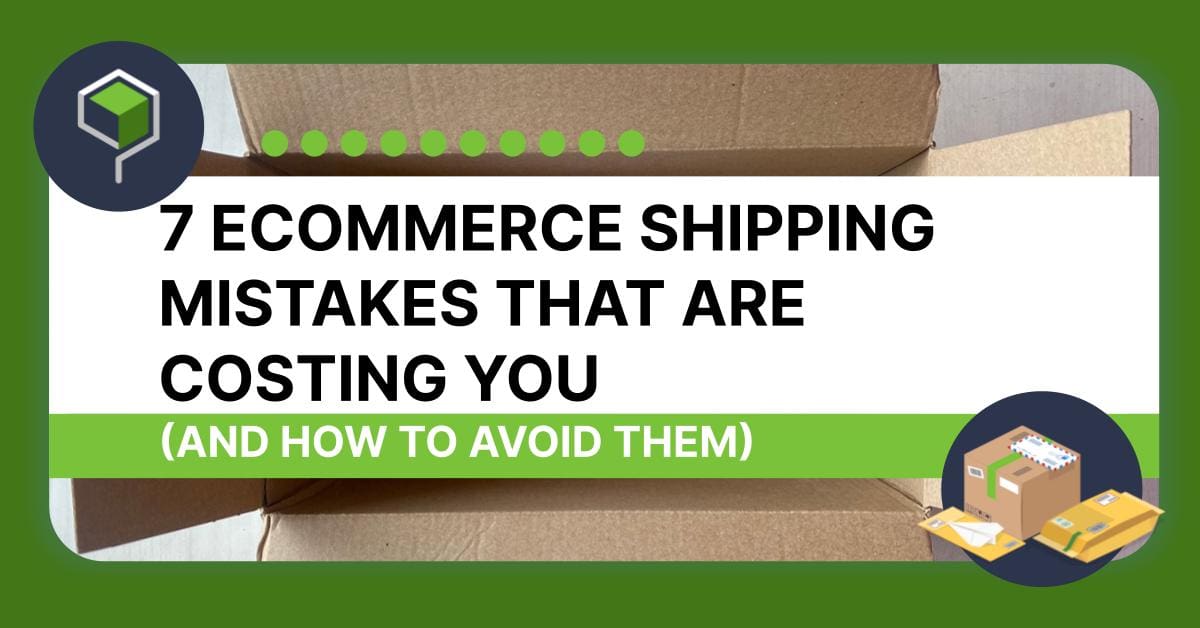7 Ecommerce Shipping Mistakes That are Costing You (and How to Avoid Them)

Running a successful shipping operation as an ecommerce business is no small feat, especially when it’s not your main area of expertise as a business owner. Getting packages from A to B by the given deadline is only half the battle; if you aren’t taking care to avoid common mistakes that increase carrier costs or result in unnecessary delays, ecommerce shipping is going to cost you far more than it should. Not just financially, but also in customer retention – and quite possibly your brand’s reputation.
In this blog, we’re going to explore common ecommerce shipping mistakes that are hurting ecommerce businesses, and what you can do to claw back valuable dollars and ensure a better customer experience.
1. Sending packages with a high DIM weight
DIM weight, or dimensional weight, is the main pricing method used by carriers to calculate the shipping cost of a package. Rather than the actual weight, which uses only the weight of the package to assess shipping rates, DIM weight takes into account both size and weight to determine how much space a package will take up in transit.
DIM weight is calculated by multiplying the length, width, and height of the package and dividing it by the ‘dimensional factor.’ The DIM factor is set by each carrier and represents the amount of space that a package occupies in relation to its weight.
In sum, DIM weight gives businesses a lot more to think about when it comes to the shipping process. A lightweight item that is very bulky, for instance, could end up costing you a lot more to ship than a small container that is heavier. One of the most common shipping mistakes is packing orders inefficiently and shipping oversized boxes, resulting in more expensive shipping rates.
By reducing the DIM weight of their packages, brands can also reduce costs. Practicing proper cartonization and using the right-sized containers for their order help to reduce package size. If a customer order contains several bulky items, it could work out cheaper to split that shipment and send it via multiple smaller packages, instead of one large one.
2. Choosing the wrong shipping methods
The appropriate method for shipping products involves more considerations than just speed or upfront cost. For example, flat-rate shipping methods are great for standardizing shipping costs for orders that are crossing several shipping zones. However, it’s a very expensive option for short-haul deliveries that are only traveling a short distance.
Certain product characteristics may also demand specific shipping options, such as hazmat shipping or freight services for extremely heavy goods. Choosing a shipping method without considering all of these factors can be extremely costly, resulting in either overpaying for shipping or paying additional surcharges.
However, it’s close to impossible for ecommerce businesses to take into account all of these factors and select the optimal shipping option manually for each order, especially as order volumes increase. Using robust shipping software makes it possible to dynamically select appropriate shipping options based on factors like delivery speed, package size and DIM weight, destination, special requirements, shipping insurance, and more.
3. Not validating shipping address
Some of the biggest shipping errors, like failed or late deliveries, result from failing to validate delivery addresses. When a customer places an order at your online store, issues can arise if the address they have provided is incorrect or incomplete.
When an order is unable to be delivered, it will get returned to the sortation center or 3PL pending address corrections. Failed deliveries or lost packages don’t only result in unhappy customers, but can mean extra costs for subsequent delivery attempts or replacement orders.
By validating the address of every order you receive, you can save money by making sure that ecommerce orders don’t end up being delivered to the wrong address or face long delivery times. Major postal carriers including USPS, FedEx, and UPS have their own address validation tools available for ecommerce businesses to use to check an address is correct and able to accept deliveries. Many shipping solutions also have address verification built in, so that incorrect addresses are automatically flagged for attention.
4. Using only one shipping carrier
It can feel much more manageable for your business to stick with one parcel carrier for shipping customer orders, especially when order volumes are small. Only having to buy shipping labels and meet requirements for one carrier can be a huge time-saver, especially if you have a small team. But while this might be convenient, not diversifying your carrier selection is a serious shipping mistake that’s going to cost you in other ways.
While your chosen carrier might be cost-effective for certain types of orders, even a nationwide carrier is not going to give the best balance of cost and speed for every single order. Certain geographic areas might have more limited service options than a regional carrier, for example. A single carrier strategy also gives your shipping operation far less resilience in cases of disruption, like adverse weather or technology issues.
Instead, it’s more cost-effective for your business to leverage multiple carrier options that represent multiple coverage areas, service levels, and shipping speeds. This way, you can select the optimal shipping method for every order.
5. Not packaging orders properly
Shipping supplies like packaging is a necessary but sizeable expense for ecommerce brands. Every product needs to be packaged properly to meet carrier requirements and protect goods in transit. Sturdy materials such as cardboard, paper, and packing peanuts to cushion items can seriously add up, especially when most of these materials are single-use.
One of the most common ecommerce shipping mistakes is cutting down on packaging in a bid to cut costs and speed up the order fulfillment process, but this can backfire in the form of a damaged package. When this happens, your business isn’t only on the hook for replacement products, but also the cost of shipping a fresh order to the customer (and let’s not forget about the reputational costs of poor customer satisfaction!)
It’s important to make sure that your warehouse team is adequately packaging all of your orders with the right materials like bubble wrap, especially fragile items that are more prone to breakage. Make sure that all of your staff are trained on what cushioning material to use for different types of products, and how to minimize needing to use void fill by using the right-size containers.
6. Accumulating accessorial charges
As shipping carriers pursue higher levels of automation and efficiency within the shipping process, they are taking a firm line on packages that don’t fit into their systems (sometimes literally).
Accessorial charges refer to a range of surcharges levied by carriers when a package requires more attention than the base shipping rate provides. This includes additional handling, oversized packages, specialized equipment, fuel surcharges, or residential delivery.
Even minor ecommerce shipping mistakes, like using too large of a box or forgetting a particular label, can cause surcharges to amount. And because accessorial charges are not applied by carriers until after the fact, they can be a nasty sting for ecommerce businesses, making the cost of delivering a package significantly more than forecast.
While it can be difficult to avoid all accessorial surcharges, there are things you can do to make them less likely. For example, using streamlined packaging and mailer envelopes that are the correct size is a lot less likely to trigger additional handling charges.
7. Not factoring in return shipping costs
It’s easy to focus only on the orders that are leaving your warehouse, rather than those coming back in. Orders with missing SKUs, defective products, or returned merchandise can end up burning a big hole in your business’s pocket if you don’t have a proactive strategy to manage return shipping costs.
Efficient order processing and accurate pick lists help to ensure that order contents are accurate before shipping. When it comes to returns that happen due to a simple change of mind, you need to decide how best to manage this financial burden while meeting customers’ expectations. For example, you could decide to pay for return shipping costs if the customer makes a return within a certain timeframe, or if the customer is willing to exchange an item or accept store credit.
One of these shipping mistakes happening here or there probably doesn’t seem like a big deal. But if they happen repeatedly – especially in connection with other shipping errors – your ecommerce business risks losing valuable dollars that could be reinvested in your business. Following the advice above helps ensure that all the costs your business is footing are necessary for successful shipments – and nothing more.



